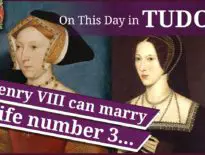On this day in Tudor history, 18th May 1554, in the reign of Queen Mary I, scholar and administrator, William Thomas, was hanged, drawn and quartered at Tyburn for his alleged involvement in Wyatt's Rebellion. It was said that he even wanted the queen assassinated.
But William Thomas was far more than a rebel, he was also the author of the first he first Italian dictionary and book of grammar to be published in English.
Find out more about him and his rather bad end in today's talk.
Also on this day in history, 18th May 1497, noblewoman Catherine Woodville, Duchess of Buckingham and Bedford, died. Who was she and how was she linked to the famous Woodvilles that rose in the reign of King Edward IV? Find out in last year’s video:
And this day in 1536 was the day chosen for the execution of Queen Anne Boleyn, so Anne prepared to die. How did she prepare herself? Why was her execution postponed? What exactly happened on this day in 1536? Find out in the 18th May 1536 video:
Also on this day in history:
- 1515 – John Stewart, 2nd Duke of Albany, landed in Dumbarton with French soldiers to obtain the regency of Scotland.
- 1581 – Birth of Mary, Lady Vere (née Tracy), gentlewoman and patron of clergymen.
Transcript:
On this day in history, 18th May 1554, scholar and administrator, William Thomas, was hanged, drawn and quartered at Tyburn for his alleged involvement in Wyatt's Rebellion.
This rebellion had been planned back in January 1554, when Sir Thomas Wyatt the Younger, son of poet and diplomat Sir Thomas Wyatt the Elder, met with his fellow conspirators at his home, Allington Castle. One of those men was Welshman William Thomas.
You’ve probably never heard of William Thomas, and his origins are rather shadowy, but he appears to have started his career serving Sir Anthony Browne, Master of the Horse to King Henry VIII. In the 1540s, saddled with gambling debts, he stole from his master and fled to Italy, and ended up being imprisoned in Italy when his crime caught up with him. Following his imprisonment, he wrote a tract in defence of King Henry VIII, possibly to get into the English government’s good books. In 1548, he wrote an Italian grammar and dictionary which was published in England in 1550 by the king’s printer, the first Italian dictionary and book of grammar published in English. In 1549, he also published “The Historie of Italie”, which he chose to dedicate to John Dudley, Earl of Warwick
It is thought that Thomas returned to England following the death of Sir Anthony Browne in April 1548 and in 1550 he was made clerk of the privy council.
In 1552 he was the Member of Parliament for Old Sarum in Wiltshire and then in 1553 for Downton in Wiltshire.
Thomas married twice. His first wife’s name is not known, but he had married Thomasine Mildmay, widow of Anthony Bourchier, by 1553, and they went on to have a daughter, Anne.
He acted in an advisory manner, in a political sense, to the young King Edward VI, with the king sending him questions to answer through one of his gentlemen of the privy chamber, Sir Nicholas Throckmorton. His biographer Dakota L Hamilton, explains that Thomas answered eighty-five questions, which he referred to as “Common places of State”, and that he also wrote six political discourses for the king.
Thomas’s royal favour ended with the death of King Edward VI in July 1553 and by December 1553, he was the member of a group of men looking to depose the Catholic queen Mary due to her plans to marry a foreign prince, Philip of Spain. It was later claimed that Thomas was keen on the idea of assassinating the queen, rather than just deposing her. He met with the group organising the rebellion in January 1554 and the plan was that Sir Peter Carew, with Thomas’s support, would lead a rebellion in the West, but after news of the rebellion was leaked, Carew fled to France and Thomas holed up with a friend in Gloucestershire. By 20th February 1554, Thomas had been arrested and imprisoned in the Tower of London. Five days later, he attempted suicide by thrusting a knife into his body, under his chest, but he survived the wound.
On 8th May he was indicted for high treason for compassing the death of Queen Mary I. He pleaded not guilty at his trial at Guildhall, but was condemned for treason. On this day in history, 18th May 1554, William Thomas was executed.
Diarist Henry Machyn, who was a merchant tailor and a citizen of London, recorded:
“The xviij day of May was drane a-pone a sled a proper man namyd Wylliam Thomas from the Towre unto Tyborne; the . . he was clarke to the consell; and he was hangyd, and after, ys hed stryken of, and then quartered; and the morow after ys hed was sett on London bryge, and iij quarters set over Crepullgate.”
His head and body parts would act as warnings to other would-be traitors of the price of treason.
The anonymous writer of The Chronicle of Queen Jane, and of two years of Queen Mary, recorded that at his execution Thomas said that he “dyed for his country”.
And that was the end of a man who had started his career in trouble and who ended his life in trouble.



I love hearing about these, to me, obscure Tudor characters. These videos have become a daily treat, Claire. There’s only one drawback I am spending a fortune on Tudor history. Seriously you are helping me build up a good collection of Tudor history. I just wish the primary sources weren’t so expensive, but I have found several useful works online through the links I have found here.